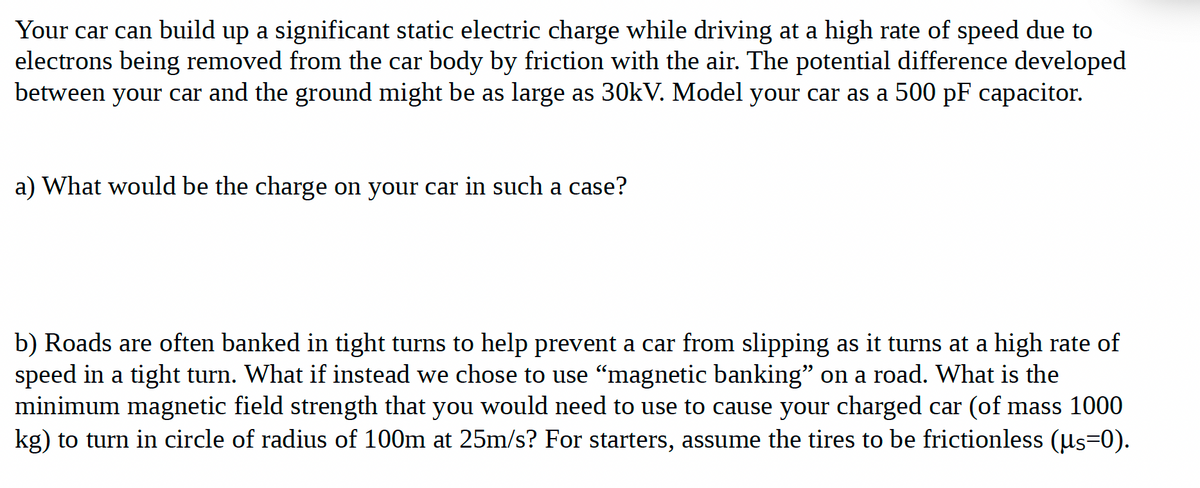Your car can build up a significant static electric charge while driving at a high rate of speed due to electrons being removed from the car body by friction with the air. The potential difference developed between your car and the ground might be as large as 30kV. Model your car as a 500 pF capacitor. a) What would be the charge on your car in such a case? b) Roads are often banked in tight turns to help prevent a car from slipping as it turns at a high rate of speed in a tight turn. What if instead we chose to use "magnetic banking" on a road. What is the minimum magnetic field strength that you would need to use to cause your charged car (of mass 1000 kg) to turn in circle of radius of 100m at 25m/s? For starters, assume the tires to be frictionless (us=0).
Your car can build up a significant static electric charge while driving at a high rate of speed due to electrons being removed from the car body by friction with the air. The potential difference developed between your car and the ground might be as large as 30kV. Model your car as a 500 pF capacitor. a) What would be the charge on your car in such a case? b) Roads are often banked in tight turns to help prevent a car from slipping as it turns at a high rate of speed in a tight turn. What if instead we chose to use "magnetic banking" on a road. What is the minimum magnetic field strength that you would need to use to cause your charged car (of mass 1000 kg) to turn in circle of radius of 100m at 25m/s? For starters, assume the tires to be frictionless (us=0).
Physics for Scientists and Engineers: Foundations and Connections
1st Edition
ISBN:9781133939146
Author:Katz, Debora M.
Publisher:Katz, Debora M.
Chapter26: Electric Potential
Section: Chapter Questions
Problem 75PQ: A long thin wire is used in laser printers to charge the photoreceptor before exposure to light....
Related questions
Question

Transcribed Image Text:Your car can build up a significant static electric charge while driving at a high rate of speed due to
electrons being removed from the car body by friction with the air. The potential difference developed
between your car and the ground might be as large as 30kV. Model your car as a 500 pF capacitor.
a) What would be the charge on your car in such a case?
b) Roads are often banked in tight turns to help prevent a car from slipping as it turns at a high rate of
speed in a tight turn. What if instead we chose to use "magnetic banking" on a road. What is the
minimum magnetic field strength that you would need to use to cause your charged car (of mass 1000
kg) to turn in circle of radius of 100m at 25m/s? For starters, assume the tires to be frictionless (us=0).
Expert Solution
This question has been solved!
Explore an expertly crafted, step-by-step solution for a thorough understanding of key concepts.
Step by step
Solved in 2 steps with 2 images

Knowledge Booster
Learn more about
Need a deep-dive on the concept behind this application? Look no further. Learn more about this topic, physics and related others by exploring similar questions and additional content below.Recommended textbooks for you

Physics for Scientists and Engineers: Foundations…
Physics
ISBN:
9781133939146
Author:
Katz, Debora M.
Publisher:
Cengage Learning

College Physics
Physics
ISBN:
9781285737027
Author:
Raymond A. Serway, Chris Vuille
Publisher:
Cengage Learning


Physics for Scientists and Engineers: Foundations…
Physics
ISBN:
9781133939146
Author:
Katz, Debora M.
Publisher:
Cengage Learning

College Physics
Physics
ISBN:
9781285737027
Author:
Raymond A. Serway, Chris Vuille
Publisher:
Cengage Learning


College Physics
Physics
ISBN:
9781305952300
Author:
Raymond A. Serway, Chris Vuille
Publisher:
Cengage Learning

Principles of Physics: A Calculus-Based Text
Physics
ISBN:
9781133104261
Author:
Raymond A. Serway, John W. Jewett
Publisher:
Cengage Learning

Physics for Scientists and Engineers, Technology …
Physics
ISBN:
9781305116399
Author:
Raymond A. Serway, John W. Jewett
Publisher:
Cengage Learning